Perfume Pagoda, a renowned religious site and scenic complex, is always an attractive destination at the beginning of each year. Located not far from the center of Hanoi, Perfume Pagoda attracts visitors from all over with its peaceful atmosphere, unique architecture, and distinctive traditional festivals. If you are planning a pilgrimage soon, let’s explore the most detailed experiences for visiting Perfume Pagoda during the festival season!
I. Overview of Perfume Pagoda
Perfume Pagoda is not only a famous spiritual tourist destination but also a sacred land where visitors can worship, pray, and immerse themselves in the beautiful natural scenery.
1. Where is Perfume Pagoda?
Perfume Pagoda, also known as Huong Son, is a complex of pagodas and temples scattered on Huong Son mountain, belonging to My Duc district, Hanoi. This place was once visited by President Ho Chi Minh, who advised: “Perfume Pagoda is a place of scenic beauty, we must cherish and preserve it for our children to enjoy and love our homeland and country more.” Having gone through many historical events, Perfume Pagoda today is a major cultural and religious center of Vietnam, with many famous spiritual destinations such as Huong Tich Cave, Thien Tru Pagoda, Trinh Temple, Giai Oan Pagoda, etc.
Perfume Pagoda is located on the right bank of the Day River, about 62km southwest of Hanoi city center. Visitors only need more than 1 hour by car to reach this famous spiritual tourist area.
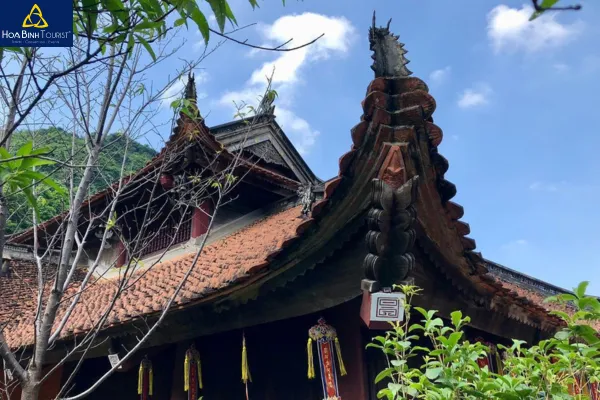
2. History of Perfume Pagoda
Perfume Pagoda dates back to the 15th century and was built on a major scale in the late 17th century. However, the pagoda was destroyed during the resistance war against the French. In 1989, Perfume Pagoda was restored by Venerable Thich Vien Thanh under the guidance of the late Venerable Thich Thanh Chan. The reconstruction of Thien Tru Pagoda lasted until 1991. Following that, the Nam Thien Mon gate and many other structures were also built, creating a magnificent architectural complex as it is today.
3. Who is Worshiped at Perfume Pagoda?
Perfume Pagoda is a complex consisting of many different pagodas and temples, so each place will worship different gods and Buddhas. Specifically:
- Trinh Temple: Located on the Ngu Nhac mountain range, worshiping Quan Tu Ma Hung Lang, who had merit in assisting King Hung Vuong VI in fighting the An invaders.
- Huong Tich Cave: Place to worship Avalokiteśvara Bodhisattva, where Princess Dieu Thien practiced and attained Buddhahood.
- Cua Vong Temple (Van Song): Worshiping “Forest Lord” Thuong Ngan Van Huong Princess Le Mai Thanh Mau.
- Thien Tru Pagoda: A large Zen monastery, a place for Buddhist practitioners to practice, preserving the Sutras, Vinaya, and Abhidharma of Buddhism.
In addition, in the Perfume Pagoda relic area, there are many other unique architectural works such as Dai Bac Pagoda, Quan Communal House, Ca Pagoda, Giai Oan Pagoda… and many beautiful caves worshiping the Five Tigers and separate beliefs.
4. Unique Architecture of Perfume Pagoda
Perfume Pagoda is a cultural and religious complex of Vietnam, including dozens of architectural works of pagodas, temples, communal houses, and caves scattered in the Yen Stream valley. Each pagoda in Huong Tich has its own unique architecture, divided into 4 main areas:
- Huong – Thien Area: Includes 8 relics: Huong Tich Cave, Thien Tru Pagoda, Trinh Temple of Ngu Nhac, Giai Oan Pagoda, Cua Vong Temple, Tien Son Pagoda, Hinh Bong Pagoda, Dai Binh Cave.
- Thanh Huong Area: Includes 2 relics: Thanh Huong Pagoda, Huong Dai Cave.
- Long Van Area: Includes 4 relics: Long Van Pagoda, Long Van Cave, Cay Khe Cave, Thanh Hoa Cave.
- Tuyet Son Area: Includes 4 relics: Bao Dai Pagoda, Ngoc Long Cave, Ngu Tri Pagoda (Fish Pagoda), Trinh Phu Yen Temple.
Perfume Pagoda’s architecture mainly relies on cliffs and caves, creating a special and harmonious blend with nature.
II. Detailed Perfume Pagoda Travel Experience During Festival Season
Coming to Perfume Pagoda, visitors not only admire the beauty like a fairyland but also have the opportunity to learn about the festivals, spiritual culture, and unique cuisine here.
1. Best Time to Visit Perfume Pagoda?
Perfume Pagoda is beautiful in every season of the year, however, the best time to visit Perfume Pagoda is during the festival season, from January to March of the lunar calendar. During this time, visitors from all directions flock to the festival, creating a very bustling and unique atmosphere. This is also the peak tourist season of Perfume Pagoda, so you should prepare carefully for a complete trip.
The main festival of Perfume Pagoda starts from the 6th day of the first lunar month and lasts until the 18th day of the second lunar month. This is the largest festival in the North, gathering 3 major religions of Vietnam and attracting millions of Buddhists and pilgrims to the Buddha land.
In addition to the solemn ceremony, visitors can also participate in many unique traditional cultural activities such as boat racing, chau van singing, cheo singing,…
If you come to Perfume Pagoda in March of the lunar calendar, you will have the opportunity to admire the red silk cotton flowers blooming brightly on both sides of Yen Stream, creating a romantic and poetic scene.
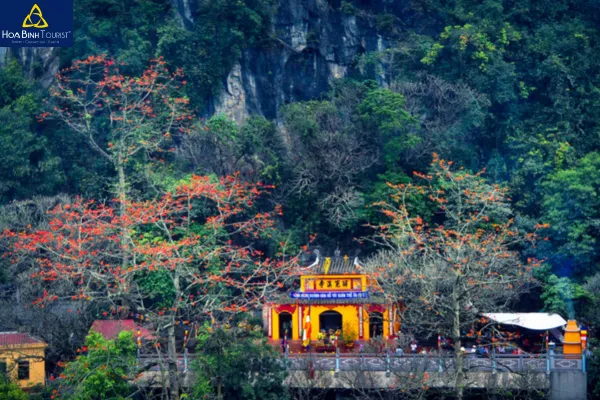
In addition, the water lily season from September to November on Yen Stream is also an interesting experience. At this time, Yen Stream becomes peaceful and poetic like a watercolor painting with pristine beauty, dotted with the pinkish-purple color of water lilies.
2. Perfume Pagoda Travel Costs?
The cost of going to Perfume Pagoda is not too expensive, mainly including entrance fees, boat trips, sightseeing, cable car, and dining. Specifically:
- Entrance ticket: 80,000 VND/person (visiting all 21 relics).
- Boat ticket:
- Main route Huong Tich: 50,000 VND/person/round trip.
- Tuyet Son, Long Van routes: 35,000 VND/person/round trip.
- Cable car ticket:
- Adults: 120,000 VND/ticket one way – 180,000 VND/ticket round trip.
- Children: 90,000 VND/ticket one way – 120,000 VND/ticket round trip.
Free entrance tickets for special class wounded soldiers, children under 1.1m tall and under 10 years old. Free entrance on November 23 (Heritage Day), December 30 – January 2 (Lunar New Year), April 15 (Buddha’s Birthday).
3. Directions to Perfume Pagoda from Hanoi
From Hanoi, you can get to Perfume Pagoda by many different means of transport:
- Motorbike: Follow Nguyen Trai – Thanh Xuan – Ha Dong – Ba La crossroads – National Highway 21B (about 59km, takes about 1 hour 30 minutes).
- Car: Follow Phap Van – Cau Gie highway – Dong Van junction – National Highway 38 – Cho Dau – Perfume Pagoda (about 62km, takes about 1 hour).
- Bus:
- Route 103: My Dinh – Perfume Pagoda (ticket price 9,000 VND/person).
- Route 75: Yen Nghia – Huong Son (ticket price 25,000 VND/person).
- Route 215: Giap Bat – Huong Son (ticket price 12,000 VND/person).
When you arrive at Perfume Pagoda, you will continue to take a boat from Duc wharf to the tourist area.
4. Preparing Offerings for Perfume Pagoda
Going to pagodas to worship is a spiritual cultural feature in the spiritual life of Vietnamese people. Perfume Pagoda is a sacred Buddha land, where visitors offer incense to worship Buddha and show their sincerity.
What to pray for at Perfume Pagoda? Perfume Pagoda is famous for granting wishes, especially for fertility. Infertile couples often come here to pray for blessings to have children.
What to prepare when going to Perfume Pagoda? That is sincerity and a heart directed towards Buddha, along with preparing offerings to offer at temples, shrines, palaces, communal houses, pagodas,… You can refer to the following offerings:
- Vegetarian offering: Incense, flowers, fruits, tea, candles, food used to worship Buddha and Bodhisattvas.
- Raw food offering: Eggs, rice, salt, raw meat to offer to Quan Ngu Ho, Bach Xa, Thanh Xa (placed at the lower altar of the Four Palaces).
- Savory offering: Chicken, pork, spring rolls, sausages… cooked carefully (placed at the Cong Dong altar).
- Son Trang savory offering: Shrimp, crab, snails, beans, sticky rice with magenta plant,… (placed at the Son Trang altar).
- Thanh Hoang god offering: Sticky rice, boiled pork leg, wine, money, gold…
- Offering for the altar of young ladies and gentlemen: Oan cakes, incense, flowers, hia shoes, hai shoes, hats, clothes, mirrors, combs…
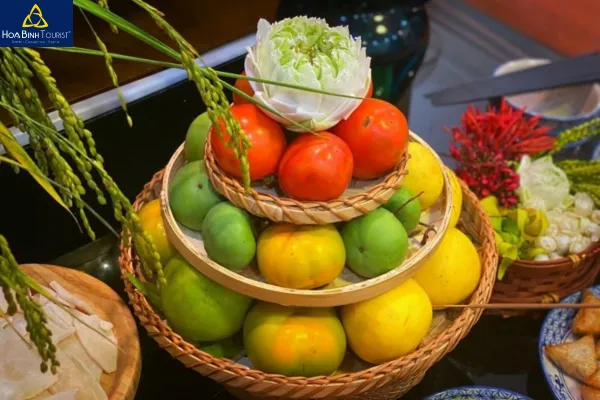
Whether the offering tray is small or large, delicious or not, it is not important, but you must sincerely worship, and it will be witnessed by the heavens, Buddhas, and deities.
5. Main Attractions in Perfume Pagoda
Perfume Pagoda has many temples, pagodas, and caves, and it takes up to 2 days to explore them all. Below are the main attractions that you should not miss:
- Duc Wharf: The first destination when you set foot in the Perfume Pagoda relic complex. The only way to enter Perfume Pagoda is by waterway along the Yen Stream.
- Yen Stream: Boating on the dreamy Yen Stream is an indispensable part of the journey to Perfume Pagoda.
- Trinh Temple: A small temple located on the right side of Yen Stream, about 500m from Duc wharf, where you need to visit before entering other relics.
- Long Van Cave: From Trinh Temple, you can take a boat to Long Van Cave, where Long Van Pagoda is located on the mountainside with beautiful scenery.
- Thanh Son Pagoda: Belonging to Thanh Huong area, it is an ancient pagoda that is hundreds of years old.
- Thien Tru Pagoda: The pagoda is known as “The most beautiful pagoda in Southern Heaven”, an architectural work of art from the Le – Nguyen dynasties.
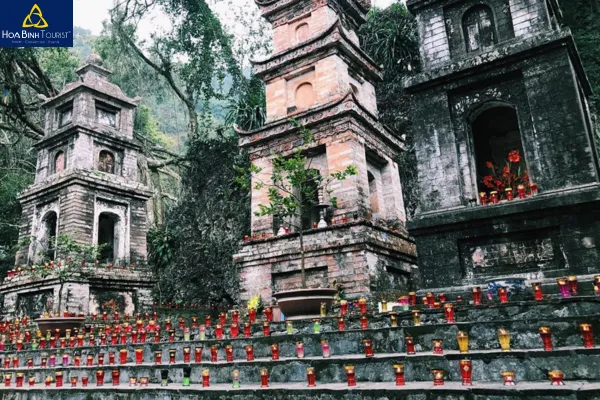
- Huong Tich Cave: The center of Perfume Pagoda tourist area, where the statue of Avalokiteśvara Bodhisattva made of green stone is placed, which was awarded the title “The most beautiful cave in Southern Heaven” by Lord Trinh Sam.
- Giai Oan Pagoda: Located on the road from Thien Tru Pagoda to Huong Tich Cave, where there is Thanh Tri well with clear water, traditionally said to be where Avalokiteśvara Bodhisattva bathed to cleanse herself of worldly dust.
- Cua Vong Temple: Temple worshiping “Thuong Ngan Van Huong Princess Le Mai Thanh Mau”, the residence of fairies who often bring news from Outer Pagoda to Inner Pagoda.
- Bao Dai Pagoda: A pagoda built in the ancient architectural style of Le – Trinh dynasties, located on the poetic Tuyet Son stream.
- Tuyet Son Cave: Located on the mountainside, inside there are many beautiful stalactites like dragon teeth.
6. Must-Try Specialties When Visiting Perfume Pagoda
In addition to the beautiful scenery and spiritual atmosphere, Perfume Pagoda also has many delicious specialties that you should not miss:
- Yam: Processed into many attractive dishes such as yam sweet soup, yam cereal cake, yam candy,…
- Che lam (sweet sticky rice candy): A sweet dish made from glutinous rice, fresh ginger, cinnamon powder, often eaten with tea.
- Sau sang vegetable: A specialty vegetable with a rich sweet taste, often used to cook soup with meat or fish.
- Perfume Pagoda apricot: A famous apricot with a mild sour taste and thick flesh, often used to soak in wine or make apricot juice.
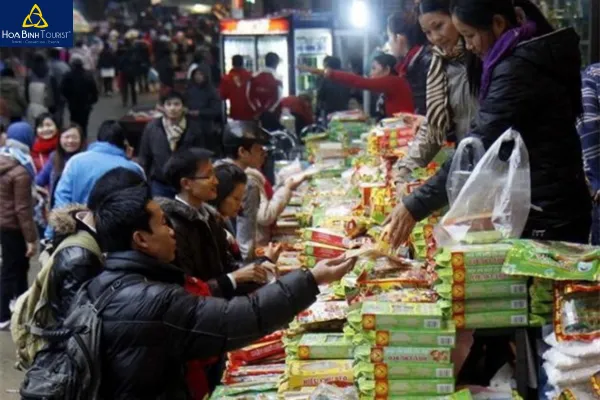
You can enjoy these specialties at restaurants near the pagoda area:
- Mai Lam Restaurant (No. 4 Thien Tru)
- Quyet Thang Restaurant (No. 1 Thien Tru)
- Thinh Khang Restaurant (Yen Wharf)
- Xuan Hinh Restaurant (Yen Stream boat wharf)
- Xuan Dung Restaurant (Nui Soi, Yen Stream)
- Cong Dong Quan Restaurant (Duc Khe)
7. Things to Know When Visiting Perfume Pagoda
- Dress code: Choose minimalist, neat, comfortable, and discreet outfits in soft colors. Avoid wearing revealing or sexy clothes.
- Plan: Make a specific plan about the itinerary, destinations, prepare offerings and appropriate clothing.
- Weather: Check the weather forecast to prepare jackets, raincoats, umbrellas,…
- Personal items: Prepare snacks and drinks because prices in tourist areas are quite expensive.
- Hygiene: Maintain general hygiene, do not litter indiscriminately.
- Security: Be careful to protect personal belongings, avoid theft.
- Shopping: Ask for prices before buying, check the expiration date of products.
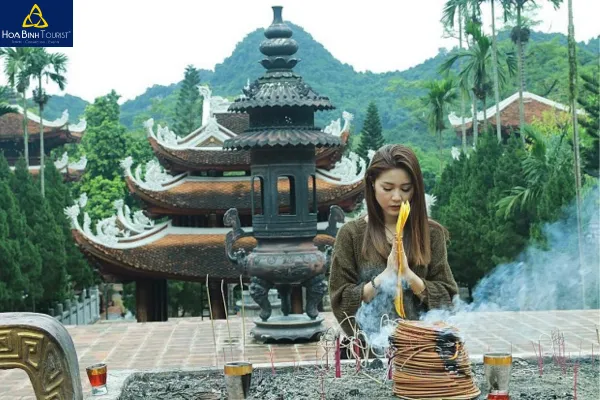
During the festival season, Perfume Pagoda is often very crowded, and it is easy for situations of touting for customers, overcharging, or superstitious services to occur. Therefore, you can consider choosing Perfume Pagoda tours for a convenient and safe trip.
III. Conclusion
Hopefully, with the detailed Perfume Pagoda festival season travel experiences above, you will have a truly meaningful and memorable trip. Perfume Pagoda is not only a spiritual tourist destination but also a place for you to return to your roots, explore traditional cultural values, and immerse yourself in beautiful nature. Wish you a peaceful and joyful journey!